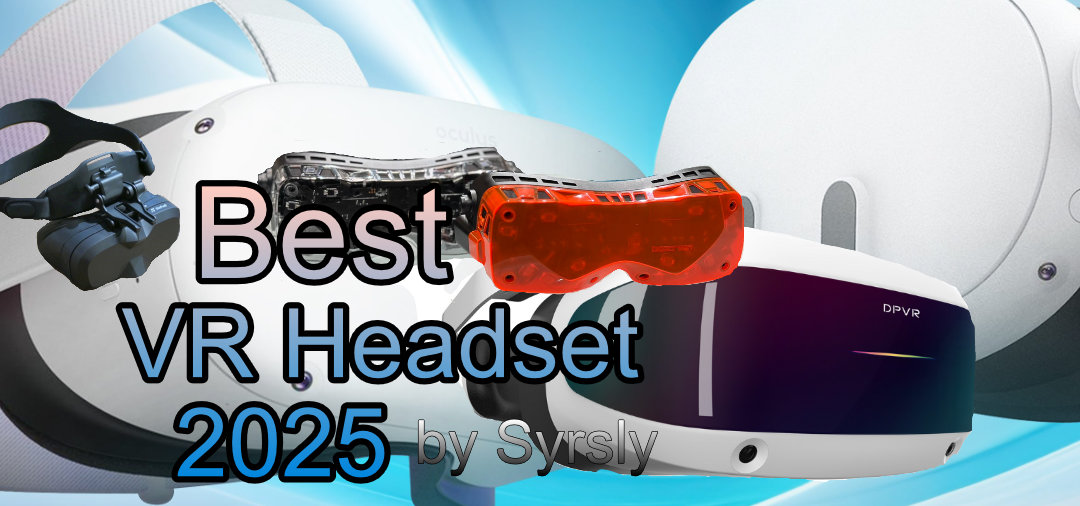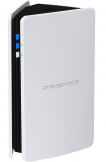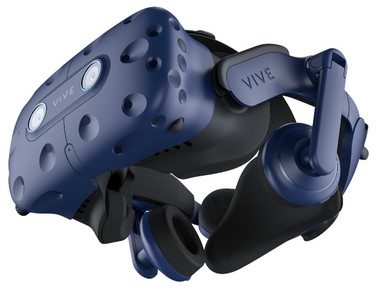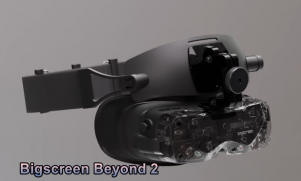Best VR Headsets 2025

 TheMrX asked me for recommendations about non-Meta VR headsets. I felt that it was a tough topic to cover quickly in a short post, so I wrote this blog article to link to him. If anyone else finds the article useful, great, but otherwise, this is mainly for him.
TheMrX asked me for recommendations about non-Meta VR headsets. I felt that it was a tough topic to cover quickly in a short post, so I wrote this blog article to link to him. If anyone else finds the article useful, great, but otherwise, this is mainly for him. ![]()
Meta has cornered the market for the past 5+ years since the original Oculus Quest released, and the Meta Quest 3 is extremely affordable for what you get. However, it's not the best hardware on the market for every use case, even in budget tier pricing. Some people will prefer to stay away from Meta products based solely on morals. For this reason, I'll give you several categories of VR headsets and for the ones where Quest 3 shines, I'll give one good alternative.
A resource I have used when shopping for myself and others for the past few years is VRCompare, a site that lets you filter headsets and compare them in numerous ways. Highly recommend this tool if you need a specific price range or feature set or date range or whatever. It's also a good place to find headsets you were unaware of.
Most Affordable (Cheap AF)
PCVR
OK, the lowest tier is the cheap AF without completely sucking category for people who are dirt poor but really want to experience some form of VR. This is a difficult category to satisfy, because it's very circumstantial. You may have a low end PC that barely supports VR but you want to use the PC for some old VR games. I'd suggest looking at getting the original HTC Vive secondhand for around $150. The full HTC Vive kit would be the headset, two base stations, power cords for each base station, a link cable to link the base stations (optional), some earbuds or built-in speakers depending on the headstrap type, and two gigantic wand controllers. This kit used to cost $900 back in 2016, but like everything else in tech, it became antiquated pretty quickly. That's not to say it sucks today. It's actually a really great wired headset that can be modified a lot. What it's not great for is media consumption, because its resolution is low by today's standards and the screen door effect is awful for readability. For gaming and sculpting, it works incredibly well, and it has extremely low system requirements when compared to a Quest 3. The tracking of Vive wands is amazing even today thanks to the base station technology, and the headset and its base stations works with trackers and other SteamVR controllers, including the Valve Index controllers!
Standalone
On a very tight budget, the Quest 3S is your best bet, and if you go this route, this also makes a decent mixed reality toy and a wireless PCVR headset. Unfortunately, it's from a company that a ton of consumers will want to avoid, and the tracking quality leaves a ton to be desired. You could also consider Pico headsets, but that brand is owned by a similarly questionable company. If you just want a wireless PCVR experience and don't care much for standalone apps, you could consider a Vive Focus headset, but I have very little experience with the early Focus headsets and don't know if any of those headsets work well.
Low Budget Multimedia Consumption
Overall Best Budget VR Headset
Quest 3 is the clear winner of this category right off the bat. The YouTube app of the Quest standalone ecosystem is insanely good to the point where nothing else offers the same experience, with or without a PC. The mixed reality features make this headset easy to work with in scenarios where you need to multitask. The hand tracking is a little finicky, especially in low light situations, but the hand tracking also helps you keep your hands free to grab real world objects like drinks and TV remotes and game controllers and batteries and so on. The lenses are also the best on the market for anything under $1,000. Connecting to a PC for PCVR is also super easy either via a USB-C cable or a good wifi 6e connection. If you don't have a modern wifi setup, you can get a router dedicated to the headset for less than $100. I recommend the PrismXR Puppis S1 router for ~$70 through Amazon US. If you have a good USBC connection and don't mind replacing the cable every now and then, that's really all you need for even roomscale VR, though.
You have cheaper options, including the Quest 3S, but they all have major drawbacks. Quest 3S has a lower IPD, tighter sweet spot, and worse lenses but a slightly improved camera configuration for mixed reality and improved controller tracking coverage. You can spend extra on Quest Pro Controllers, which are compatible with Quest Pro, Quest 3, and 3S, if you want more reliable tracking, but I can't personally vouch for those controllers as I have not even tried them. I personally doubt their effectiveness, but at $250, they're worth the gamble if you don't already have tons of base station stuff... of which I have tons.
If you'd like to avoid Meta and Pico products on moral grounds or just don't want to be tied to those platforms for privacy concerns or whatever your reasoning, your options are reasonable as long as you set your expectations appropriately.
If you're OK with a tether to a PC or console, PlayStation VR2 a.k.a. PSVR2 is your absolute best option for media consumption and seated experiences. It works with PC via a very affordable adapter - seen some as low as $28 on AliExpress - but the PSVR2 PC adapter's feature set on PC is severely limited. That said, if you have a PS5 already, the features of the PSVR2 are amazing especially for someone new to VR. The eye tracking is actually utilized by a few games in the PS5 library, which is more than I can say for any other eye tracking enabled headset/platform. Unfortunately, I found the headstrap design unbearable for anything that wasn't a seated experience, and the strap is not easily swapped out and the one decent-looking comfort mod for it, the Globular Cluster CMP2, did not make much difference to me. I tried many other comfort mods since and nothing improves on the CMP2 yet. One major perk of the PSVR2 that makes it great for PCVR is its controllers are very high quality with great joysticks and triggers.
If you'd rather have something more comfortable that you could potentially grow with, I highly recommend something secondhand like a HTC Vive. Just know what you need to make it work and know that it's very dated and will have major drawbacks like the very prominent screen door effect. The lower resolution is actually a perk since it means your PC doesn't have to be super powerful to render to it at 100% scale. That doesn't truly matter since you can scale down resolutions in SteamVR quite easily, but I find that scaling some apps breaks their UIs and visual effects and sometimes, the 100% on Vive looks a lot better than scaled down Quest 3. Modding a HTC Vive is very easy to do, too, with many 3d printable parts available and a lot of old units and accessories on the used market. You can do with either a solid headstrap or an elastic one. I personally find elastic headstraps more comfortable for active gaming.
Lightest for Virtual Screens
The Xreal Air is only $197 and a similar size to bulky Meta smartglasses... okay, maybe a little bulkier. These glasses are great for use as a virtual screen. I used them once very briefly, and I thought the image quality was pretty good. Audio was decent. It won't stand the test of time, mind you, and you'll likely want to trade these out in a couple years for better AR glasses or a MR headset. You could also consider the XReal Air 2 for $300, but I have not used the newer model and it has lower review scores, so the safe bet is the original model.
Mid-Tier Budget VR Gaming
Once you pass the $500 price cap, your options for PCVR and standalone gaming open up tremendously! Below are just my top recommendations at this time and you can definitely find other options out there.
Non-Meta Standalone VR
I personally would like to try the Vive XR Elite, but its reviews left me hesitant to bite with such a high initial price tag ($1100). Its price has dropped significantly since release, currently sitting at $800 new in a good bundled game deal on Amazon or around $600 on ebay. I personally think that price is alluring, and it leaves room in a typical mid-tier budget for the latest HTC trackers and a few software picks, like Virtual Desktop. $800 is easily financed, too, making it an easy product to jump into VR for the first time with. Only huge fear I have is it won't fit my big head as well as I want. Best to try it out somewhere first, but all the stores do these days is demo Meta headsets and they can't even seem to demo those right.
Budget VR Headset for Developers
Developers of VR games and apps have to test on hardware that customers are likely to use, which is often going to mean using Meta devices, but if you want something that isn't tied to Meta and has similar amenities and is decently popular, look at Pico headsets. If you're already tied to Meta and just want to improve your comfort and productivity, I recommend the KKCobVR Q3 Pro, which offers a flip-up-ish visor design that's great for sitting at a desk and not obstructing your view more than it has to. If you're developing for SteamVR, you could also consider the DPVR E4 or Vive Cosmos Elite, both of which have flip-up displays, making them good for desk/sim use.
Pro Tier VR Headset for Developers & PCVR Enthusiasts
I personally think the expensive headsets should be avoided for the most part for testing purposes simply because they aren't the hardware most users will have at a consumer level. If you're wanting something to test out standalone hardware on, look at the previous category. This category is for developers who just want something awesome to wear as a daily driver. This tier is stupidity incarnate, but if you got funds to burn, there are a lot of options. Hookman suggested the upcoming MeganeX 8K as a reasonably expensive flip-up headset that looks really comfortable assuming its headstrap works well for your head shape. ScarredGhost also covered the headset from an event a few months ago. This headset promises a lot of very useful and convenient features which honestly, I would love in my own personal setup. Note that while this headset is expensive, it's made even more expensive once you factor in base stations and controllers and headphones/earbuds and cable management. That's right, it's another tethered PCVR headset.
BigScreen Beyond 1 or... 2?!
If you're looking for something a little more time-proven, there's the BigScreen Beyond, which recently had a sequel announced with optional eye tracking, and you can combine that headset quite well with Valve Index controllers and some 2.0 base stations from the Steam store. However, it, too, has a tether and requires a PC, which is the only reason other than a tight budget that I don't want one. Well, that and a lack of mixed reality capabilities, but that isn't exactly a deal breaker for me.
Here's the official BigScreen Beyond 2 announcement video:
If you're at this tier and looking for wireless PCVR, I don't blame ya for thinking "I thought Syrsly was all about wireless VR! What gives!"
All-Around Best Wireless VR Experience (At Any Price)
Since 2014, I've been toying with wireless PCVR setups for most of my time in VR... and I must say, tethers are so annoying to me that wireless was definitely inevitable. That said, wireless video signals are a challenge and come with a ton of drawbacks. If you're into seated experiences or only play in a small area close to your PC, a tether might be the way to go for you. However, everyone else should at least consider wireless options, especially since in 2025, there are some semi-decent options.
 The Quest 3 is my go-to at this tier and all other tiers. It has the best software support of anything, and it works great with wifi 6e and wifi 7 routers. It doesn't connect to my main home router or its mesh network since the last home network upgrade, but it worked well enough on my previous Eero wifi 5 mesh setup. I believe this is because my new setup is wifi 7 and it confuses the Quest 3, making it return erroneous authentication errors. Puppis S1 acts as a middleman solution to connect the Quest 3 to my PC to share its wired connection.
The Quest 3 is my go-to at this tier and all other tiers. It has the best software support of anything, and it works great with wifi 6e and wifi 7 routers. It doesn't connect to my main home router or its mesh network since the last home network upgrade, but it worked well enough on my previous Eero wifi 5 mesh setup. I believe this is because my new setup is wifi 7 and it confuses the Quest 3, making it return erroneous authentication errors. Puppis S1 acts as a middleman solution to connect the Quest 3 to my PC to share its wired connection.
The Quest 3 is easy to modify and make your own in many ways, including custom headstraps, facial interfaces, charging docks, and hotswappable batteries among many other things. It's affordable at pretty much any budget, especially if you buy secondhand, and it has the largest standalone app marketplace of them all! It has 2 free wireless pcvr link apps and a built-in Oculus Link app that works wired or through wifi and also has great support from Virtual Desktop. The mixed reality offerings are mostly small experiences, but there are some really memorable experiences, some with moderate replay value.
If I didn't already cave to Quest 3 a year ago, I was eyeing the Pico 4 Ultra, which is now available for $900 in some places or $1100 on Amazon US. That's a reasonable price if you ask me for what's basically a well futureproofed VR headset for the next half decade, but it's tied to the same parent company as TikTok, so it's not much better than being under the Facebook/Meta umbrella and doesn't have the same level of third party hardware support. The controllers are decent with decent tracking coverage and nicer joysticks than I expected... but nothing gives you haul effect joysticks at this time other than the recent Pimax Crystal/Portal offerings. The wifi experience is pretty comparable to the Quest 3 or 3S but with added wifi 7 support. The FOV is much better, and the passthrough looks twice as good.
 If you're looking to avoid big social network companies being tied to your headset, the next best thing that I've tried is the Vive Pro (Eye) with the original HTC Vive official wireless adapter. The wireless adapter is bulky and looks weird and has some major technical limitations, so do your research before buying it. However, once you have the adapter working, the Wigig signal is strong enough for a very smooth wireless PCVR visual experience and has enough bandwidth for a ton of clarity on the right PC. This adapter sells for $250Â and works with the OG Vive, Vive Pro Vive Pro Eye, Vive Pro 2, and Vive Cosmos, though for anything other than the OG Vive, you will likely have to by an adapter for your adapter. Thankfully, HTC sells accessories directly and seems to have plenty of back stock. The HTC site has a disclaimer stating that the adapter may not work on some AMD systems, but I've successfully run the adapter with 3 different AMD rigs with no AMD-related issues other than a few unexplained crashes on the 1600X when the adapter was brand new. Since then, the bios/firmware updates seem to have stabilized the adapter driver.
If you're looking to avoid big social network companies being tied to your headset, the next best thing that I've tried is the Vive Pro (Eye) with the original HTC Vive official wireless adapter. The wireless adapter is bulky and looks weird and has some major technical limitations, so do your research before buying it. However, once you have the adapter working, the Wigig signal is strong enough for a very smooth wireless PCVR visual experience and has enough bandwidth for a ton of clarity on the right PC. This adapter sells for $250Â and works with the OG Vive, Vive Pro Vive Pro Eye, Vive Pro 2, and Vive Cosmos, though for anything other than the OG Vive, you will likely have to by an adapter for your adapter. Thankfully, HTC sells accessories directly and seems to have plenty of back stock. The HTC site has a disclaimer stating that the adapter may not work on some AMD systems, but I've successfully run the adapter with 3 different AMD rigs with no AMD-related issues other than a few unexplained crashes on the 1600X when the adapter was brand new. Since then, the bios/firmware updates seem to have stabilized the adapter driver.
Quick note: TPCast also made a wireless router system for the original Vive. I was never able to make that system work for more than a couple minutes and I doubt it's forward compatible with the Vive Pro headset models. I cannot recommend TPCast's products at this time.
Some headsets I like a lot are designed to be wired. It really sucks, but that's the world we live in. Unless you're willing to be under a social media giant's boot, you have to spend a lot to get a good experience. HTC abandoned their legacy hardware in favor of reinvention. Their new headsets are mostly standalone offerings. Their wireless adapter never got a second edition to remedy the flaws of the initial release. They made adapters for newer Vive headsets, but the adapters are just bandaids on top of a gaping wound. The standalone headsets they offer are unfortunately not as well designed as the Quests and Picos out there. HTC's controllers after the Vive wand are all garbage. I say that having kept my original Vive in use for the past decade and still using the original wand controllers with few issues.
That's all the advice I have to give at this time, but my opinions and knowledge of VR gear are forever evolving as new devices release and I get to try new hardware. Sometimes, what worked before stops working, but other times, what isn't broke never seems to break, so tread carefully in the secondhand market, and if you have concerns, feel free to reach out to me on Bluesky.
If you're curious what VR gear I currently have, I have a recently updated but still kind of plain list of my current VR gear here.

